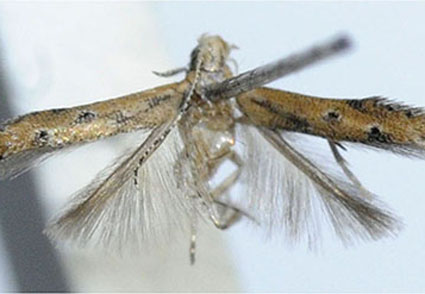Abstract
Tawaya gen. n. and its four new species (T. flaventia sp. n., T. rutila sp. n., T. luteola sp. n. and T. armeniaca sp. n.) are described from Borneo. A key to the described species is provided. The taxonomic position of a new genus within the subfamily Dichomeridinae (Gelechiidae) is proposed based on a combination of molecular and morphological analyses.
References
Abraham, D., Ryrholm, N., Wittzell, H., Holloway, J.D., Scoble, M.J. & Löfstedt, C. (2001) Molecular Phylogeny of the Subfamilies in Geometridae (Geometroidea: Lepidoptera). Molecular Phylogenetics and Evolution, 20 (1), 65–77. https://doi.org/10.1006/mpev.2001.0949
Applied Biosystems (2005) Sequence Scanner. Version 1.0. Applied Biosystems: Product Bulletin 106PB13-01. Available from: https://sequence-scanner.informer.com/1.0/ (accessed 6 July 2021)
Belshaw, R. & Quicke, D.L.J. (1997) A molecular phylogeny of the Aphidiinae (Hymenoptera: Braconidae). Molecular Phylogenetics and Evolution, 7, 281–293. https://doi.org/10.1006/mpev.1996.0400
Darlington, P.J. (1957) Zoogeography: the geographical distribution of animals. John Wiley & Sons, Inc., New York, 675 pp.
Falkovitsh, M.I. & Stekolnikov, A.A. (1978) Introduction. In: Medvedev, G.S. (Ed.), Key to the insects of European part of Russia. Vol. 4. Lepidoptera. Part 1. Nauka, Leningrad, pp. 5–27. [in Russian]
Gillespie, J.J., Johnston, J.S, Cannone, J.J. & Gutell, R.R. (2006) Characteristics of the nuclear (18S, 5.8S, 28S and 5S) and mitochondrial (12S and 16S) rRNA genes of Apis mellifera (Insecta: Hymenoptera): structure, organization, and retrotransposable elements. Insect Molecular Biology, 15 (5), 657–686. https://doi.org/10.1111/j.1365-2583.2006.00689.x
Klots, A.B. (1970) Lepidoptera. In: Tuxen, S.L. (Ed.) Taxonomist’s glossary of genitalia in insects. Munksgaard, Copenhagen, pp. 115–130.
Hancock, J.M., Tautz, D. & Dover, G.A. (1988) Evolution of the Secondary Structures and Compensatory Mutations of the Ribosomal RNAs of Drosophila melanogaster. Molecular Biology and Evolution, 5 (4), 393–414.
Hodges, R.W. (1986) Gelechioidea: Gelechiidae (in part). Fasc. 7.1 Dichomeridinae. In: Moths of America North of Mexico. The Wedge Entomiological Research Foundation, Washington, pp. vii–xiii + 1–195.
Kimura, M. (1980) A simple method for estimating evolutionary rates of base substitutions through comparative studies of nucleotide sequences. Journal of Molecular Evolution, 16 (2), 111–120. https://doi.org/10.1007/BF01731581
Kumar, S., Stecher, G. & Tamura, K. (2016) MEGA7: Molecular Evolutionary Genetics Analysis Version 7.0 for Bigger Datasets. Molecular Biology and Evolution, 33 (7), 1870–1874. https://doi.org/10.1093/molbev/msw054
Larsen, N. (1992) Higher order interactions in 23S rRNA. Proceeding of the National Academy of Sciences of the United States of America, 89, 5044–5048. https://doi.org/10.1073/pnas.89.11.5044
Meyen, S.V. (1987) Geography of macroevolution in higher plants. Journal of General Biology, 48 (3), 291–309.
Patterson, J., Chamberlain, B. & Thayer, D. (2004) Finch TV. Version 1.4. 0. Publ. by Authors. [program]
Ponomarenko, M.G. (1993) Functional morphological analysis of male genitalia of the gelechiid moths of the subfamily Dichomeridinae sensu novo (Lepidoptera, Gelechiidae). Entomilogical Review, 72 (2), 26–45.
Ponomarenko, M.G. (2005) Gelechiid moths (Lepidoptera, Gelechiidae) of the Palaearctica: functional morphology of the male genitalia, phylogeny and taxonomy. Meetings in memory of N.A. Cholodkovsky, St.-Petersburg, 58 (1), 1–139. [in Russian]
Robinson, G.S. (1976) The preparation of slides of Lepidoptera genitalia with special reference to the Microlepidoptera. Entomologist´s Gazette, 27, 127–132.
Schmitz, J. & Moritz, R.F.A. (1994) Sequence analysis of the D1 and D2 regions of 28S rDNA in the hornet (Vespa crabro) (Hymenoptera, Vespinae). Insect Molecular Biology, 3 (4), 273–277. https://doi.org/10.1111/j.1365-2583.1994.tb00177.x
Shirk, P.D., Perera, O.P., Shelby, K.S., Furlong, R.B., LoVullo, E.D. & Popham, H.J.R. (2015) Unique synteny and alternate splicing of the chitin synthases in closely related heliothine moths. Gene, 574, 121–139. https://doi.org/10.1016/j.gene.2015.08.001


